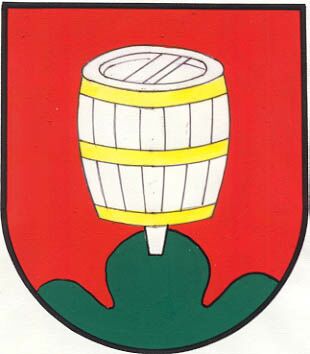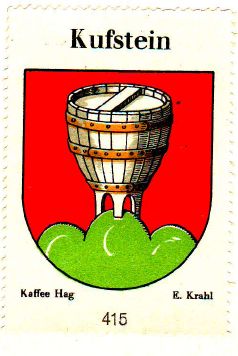Kufstein: Difference between revisions
Jump to navigation
Jump to search
Knorrepoes (talk | contribs) (Created page with '{|width="100%" style="color:black; background-color:#ffffcc;" |width="15%"|50 px|left |width="70%" align="center" |'''Heraldry of the World<br>Civic heraldry…') |
Knorrepoes (talk | contribs) m (Text replace - "'''Origin/meaning :'''<br>" to "====Origin/meaning====") |
||
| Line 12: | Line 12: | ||
[[File:kufstein.jpg|center]] | [[File:kufstein.jpg|center]] | ||
====Origin/meaning==== | |||
The arms are first seen on the local seal of Kufstein dating from 1376. The seal showed a canting Kufe, or salt barrel, above some mountains rising from some waves. The barrel obviously was chosen as a canting symbol and a symbol for the salt mining in the area. The mountains and waves are symbols for the surroundings. During later centuries the waves disappeared and the mountains gradually changed into the present mountain. | The arms are first seen on the local seal of Kufstein dating from 1376. The seal showed a canting Kufe, or salt barrel, above some mountains rising from some waves. The barrel obviously was chosen as a canting symbol and a symbol for the salt mining in the area. The mountains and waves are symbols for the surroundings. During later centuries the waves disappeared and the mountains gradually changed into the present mountain. | ||
Revision as of 16:18, 1 April 2012
| Heraldry of the World Civic heraldry of Austria - Österreichische Gemeindewappen |
KUFSTEIN
State : Tirol
District : Kufstein
Origin/meaning
The arms are first seen on the local seal of Kufstein dating from 1376. The seal showed a canting Kufe, or salt barrel, above some mountains rising from some waves. The barrel obviously was chosen as a canting symbol and a symbol for the salt mining in the area. The mountains and waves are symbols for the surroundings. During later centuries the waves disappeared and the mountains gradually changed into the present mountain.
| The arms in the Coffee Hag album +/- 1932 |
Literature : Köfler and Beimrohr, 1995


